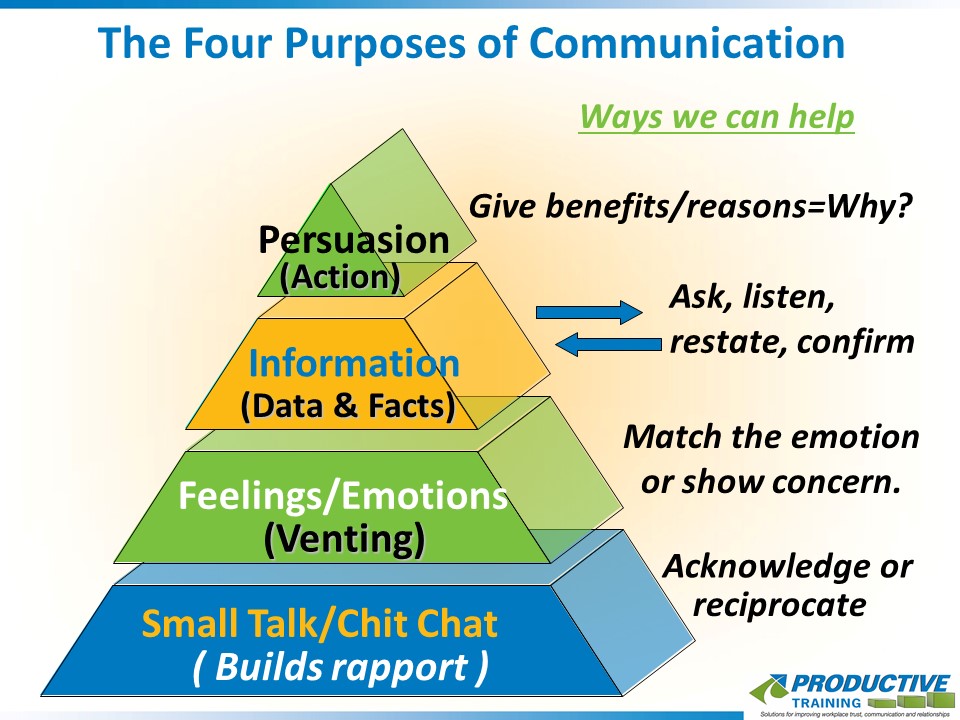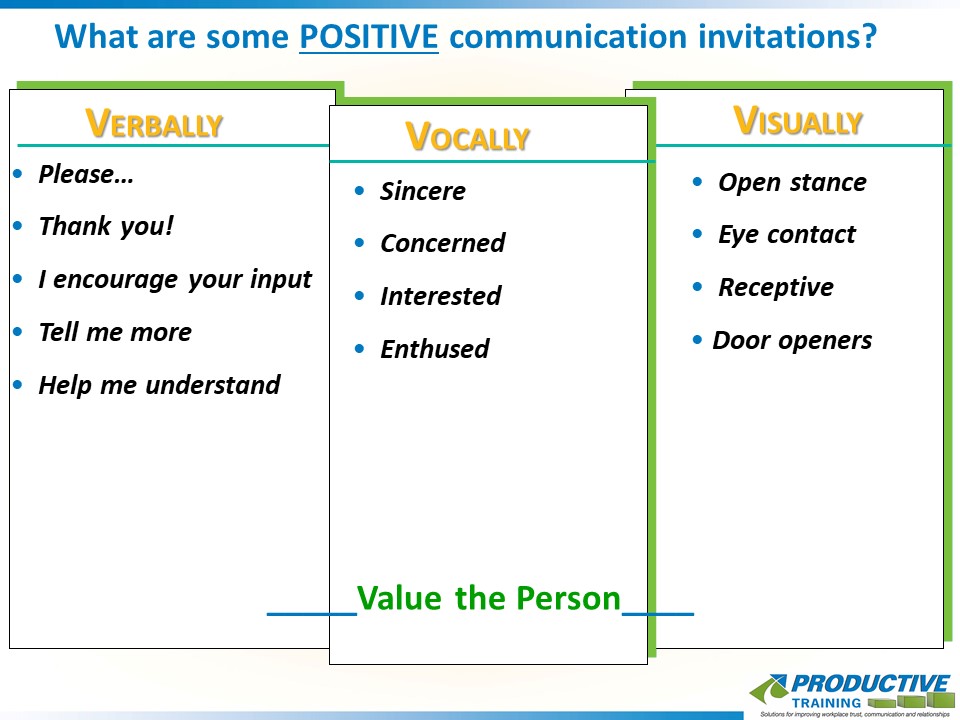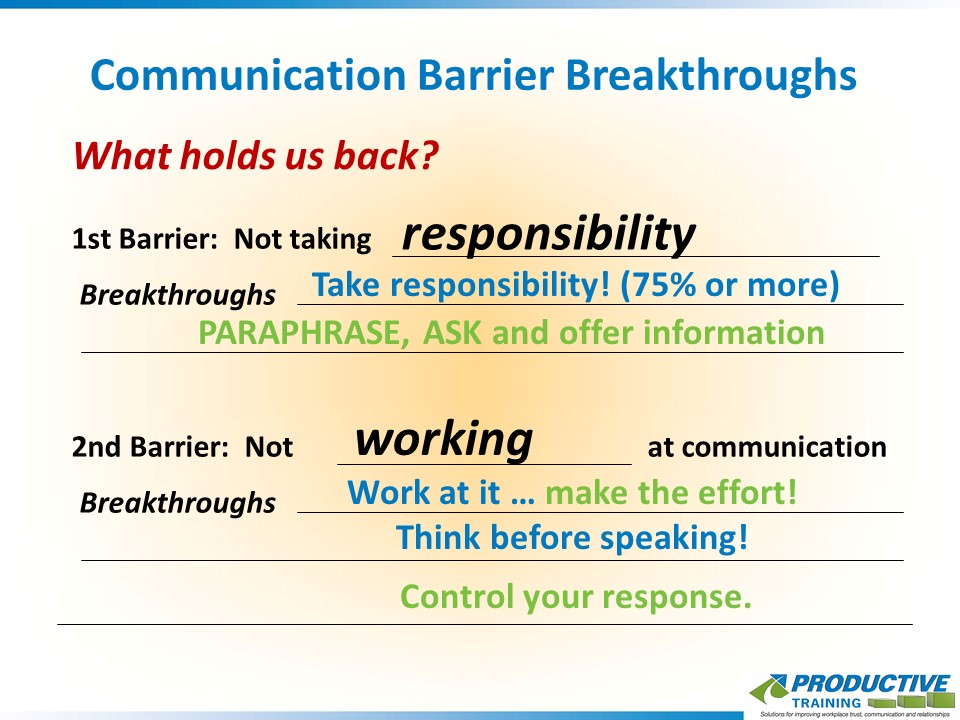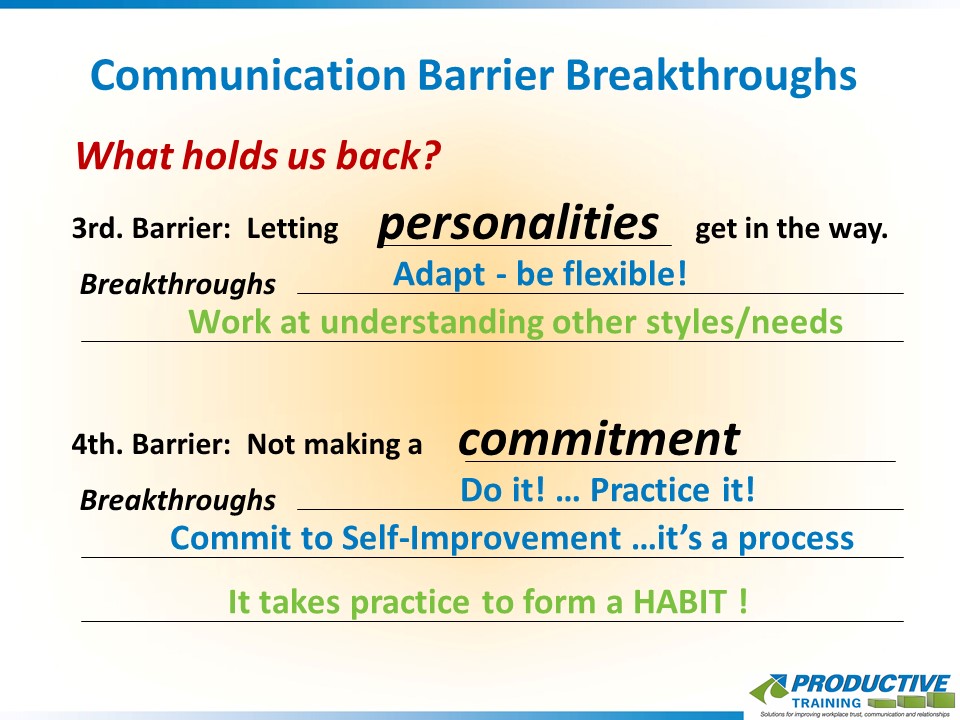Joseph Tabers, CSP, President of Productive Training, Inc.
Editor’s note: This article is an adaptation of the live webinar delivered by Joseph Tabers in 2020. His comments have been edited for clarity and length.
You can read the summary article here as part of the July 2020 Retirement InSight and Trends Newsletter, worth 1.0 CE when read in its entirety (after passing the online quiz.)
By Joseph Tabers, CSP, President of Productive Training, Inc.
The need for information and good communication is so essential for clients and people today to provide reassurance, and sometimes, peace of mind. We’re going to review some proven techniques for enhancing communication effectiveness face-to-face, in meetings or over the phone, and online and any other form of digital communication.
What is the Definition of Communication?
Communication is getting people to listen to us, understand us, and respond to what we say as we want them to. It sounds reasonable at first thought, but then on second thought, it sounds one-sided, right? It’s a little bit manipulative. Growing up, you probably heard mom, dad, or somebody yell, “If you just listen to me and do what I ask, we’d have no problem!” So often, it sounds one-sided, and it may be appropriate when someone is frustrated, but from adult to adult, it does sound manipulative. So that is the problem.
A better definition of communication is a mutual exchange, a give and take. If you have ever played table tennis (ping pong), you know what it’s like for your opponent to slam the ball and be a good server, where you spend more time chasing the ball. The game is no fun when it’s one-sided, versus getting a volley exchange that is more fun and invigorating, but more memorable. Keep this definition in mind.
One good thing to ask yourself in a typical meeting with a member or client on the phone or otherwise is, should our exchange by 50% me, 50% them? Should it be 60% me, 40% them? Is it 90% me, 10% them? What is the exchange, the balance? It’s not to say that it always has to be 50/50. You are the one they’re calling for expertise, and it may be appropriate to be 70/30 or 80/20.
Pay attention to that balance, so if you catch yourself dominating the conversation, pull back, and give them some percentage of exchange.
What are the Four Purposes of Communication?
One of the goals when we communicate it to make sure we’re connecting with those individuals in a way that they understand. Connections don’t happen on their own, just like a cell phone or Wi-Fi connection. Sometimes you have to move to a place where you get a more reliable signal or clearer signal. Sometimes we have to reconnect or move with our computer shut down and reboot to have a better connection.
There are four main reasons why you and I communicate with others. Let’s look at the base of the pyramid below. The first purpose of communication is small talk. What’s the point of small talk? A small connection, a baby connection, to build rapport.

“Nice day, isn’t it? Did you see that game last night? It’s nice that the weather is warming up a little bit! Spring is on its way.” We talk about the weather, sports, and current events. There are different discussions that people have to connect, and small talk is one way that’s usually safe to connect. Smile, and say good morning.
The second purpose of communication is sharing feelings and emotions or sometimes venting. It can be good news and maybe just excitement to share or bad news that may be frustration or venting. The question then is, what’s the point of that in the workplace? We all have times when we need to express some good or bad feelings about something. If you try to cork feelings, they will come out anyway, so sooner or later, people will talk about their feelings.
When someone is communicating feelings and emotions, usually, they want someone to acknowledge it. For example, when someone says, “Guess what? Today is my birthday!” Usually, they want someone to acknowledge it by saying, “Happy birthday!” You have two choices. You can match the emotion, especially if it’s a positive one. Meet them where they’re at if they’re happy, be happy for them; if they’re excited, to be excited for them.
Conversely, if they’re a little frustrated or concerned, show some concern. If they’re upset, acknowledge you understand that they’re upset. “I can see you’re upset.” Try to meet them where they’re at from the emotion. Rule of thumb is that we don’t have to change the emotion or fix it. However, we can at least acknowledge it. Meet them where they’re are. Sometimes that’s the only purpose of the conversation – to share that concern or feelings and have someone acknowledge it.
The third purpose of communication is where the financial industry spends most of the time communicating data, facts, and information that people want to know. “How are we doing? Do I need to make any changes in my account or my benefits package?” They’re looking for information and answers, and you may be the one providing that information and answers depending on the conversation. Ask, listen, restate, clarify, check, confirm, double-check, and confirm.
The final purpose of communication is persuasion. How do you get someone to act or move to the next step?
Sometimes we go through all four of these purposes in one conversation. Sometimes we get stuck on one for a while. Or the purpose is just to have a little small talk or just to share a little feeling and then spend the most time information setting.
Tips for Establishing Common Ground
The first tip and easiest thing to do upfront to establish common ground is to give the big picture first, or the context. For example, let’s say you have a member or client on the phone and you start the conversation by saying, “I was just going through some updates in my client list, and your name came up, and I thought I’d give you a call just to check-in and see how you’re doing?” The big picture is, why are we having this conversation? How did the name come up? Why are we having the call? The big picture goes a long way to make sure someone knows the reason for the conversation before the conversation.

The second tip is to give examples. “A few of my clients are worried about the markets’ volatility now and whether they should make any changes to their retirement savings.” What’s the example that you’re giving to help them know that 1. You’re thinking of them and 2. Something concrete that they can relate to that has something to do with their life or their situation.
The third tip is to give definitions, defining terms, even basic terms – things like quality or peace of mind. What do those mean? What do they mean for them? What do they mean for us? When someone says they need something as soon as possible, stop and clarify what it means for them. For some people, it’s by the end of the day, for others it might be any time before the end of the week. Clarify definitions, even on basic terms. It helps prevent misunderstandings later.
Tip number four is to use comparisons. How is this like something else? Communication is a lot like swimming – to get better at it we have to get into the water and take some strokes. What are we comparing the conversation or the content of the conversation too? What is an analogy?
Tip number five is to use visual aids. Many of us have them. How can you communicate a concept more simply to say or show what I mean?
The final tip is to use facts and figures. The financial industry is in the facts and figures world, but my caution here is that this gets used too often. I’ve heard people even say the facts should speak for themselves. Other people might say, well, they’re not talking to me. Facts aren’t always crystal clear. There are facts behind the facts. It depends on the context or how what they are comparing those facts to. Don’t just assume the facts are clear. When there are feelings and emotions involved, there are other things that they may want to know as well.
We’re Always Communicating Even if We Choose Not To
Three ways to communicate are verbally, vocally, and visually. What we say, how we say it, and how we look or appear when we say it or our facial expressions, body language.

Think about your communication. Where can you be clearer with your visuals or support for visuals? Do you sound reassuring, confident, or do cautious/skeptical? What’s the tone of voice or the emotion people hear?
The second method of communication is the words we use. In the middle section above, it’s the vocal delivery. What do they hear in the way we say things, and what’s appropriate for that message? How do you say but the actual words you choose to say? How do you phrase it? “Please, thank you, excuse me, do you have a minute? I appreciate what you’re saying.” It’s the words we choose. Think of common courtesies. Those would definitely be expected, and hopefully, from a professional, they would be something that clients and members will hear more often.
We all have phones and leave voicemails. Leave yourself an audible message to hear how you come across to clients to check in on yourself. I’ll say, “Hey Joe, this is Joe. Just calling to see how things are going with the customers. Any updates we need? Any project status that would be helpful for me to know? Please give me a callback.” It is helpful because sometimes our energy level is low, and we can sound too serious.
The last method of communication is visual. If you can be face-to-face with a member or client, obviously being professional is a rule of thumb. How do we come across visually if the visual is absent, i.e., via a phone call? Put more emphasis on the left side, the vocal.
What are negative communication tendencies to avoid? Think of it this way: people are sending out invitations all the time. It’s been said that over 90% of the messages are in our 24-hour news cycle is negative. We are told what’s wrong and instead get only little gems or some glimmer of hope or good news.

Sometimes you have to look for the good to tune out the bad. With our clients and members, it’s the same thing. Sometimes they want to hear reassurance and what’s good, instead of what’s wrong and the worry that goes with that. We are saturated with information, and sometimes that information isn’t always helpful.
So How Do You Know They Understand?
In the basic communication model, the sender will send a message and say something, and then the receiver might echo or say something back, and it goes back and forth as many times as needed.
The question then is, who’s responsible for understanding or who’s responsible for making sure there’s understanding? When I deliver training sessions live with people in a room, they will often allude to the fact that the sender is more responsible because they’re the ones starting the conversation. Those who give this a little more thought will say that both have responsibility for making sure there is understanding. But instead of a 50/50 responsibility, we suggest going the extra mile and making it 75/75. In other words, don’t assume the other person is understanding unless they’re taking the initiative or you’re taking the initiative.

For example, let’s say you have a headache right now. I might say, “Do you want me to go over that again, or do you need another example, or do you want to schedule a time when you’re feeling better to go through this?” If you’re getting visual feedback or audible feedback from someone, it’s time to take more responsibility for the communication. Suppose you see a puzzled look – that’s a signal that someone needs to take more responsibility. You could do this when you are the receiver of communication, and communication is confusing. You can say, “Can I stop you for a minute? Can you go back and explain that or give me an example?” When both parties take more responsibility as a sender or receiver, there is a much higher percentage chance of preventing misunderstandings.
How do you make a one-sided conversation into a two-sided conversation? Here are two tips.
- Ask: So, give you some feedback. Tell me what you think. What would be helpful for you next?
- Paraphrase: Sometimes called the echo technique or paraphrasing, is to put what you heard in your own words. “So, let me see if I understand. What you’re saying is ….. or let me make sure I’m not missing something.” There are dozens of words and ways to paraphrase, but basically, you’re segueing from their conversation or their words and putting it in your own words to see if there’s a connection. Remember, the goal is mutual understanding expression equaling impression or connection.
These methods are insurance policies for good communication. If you could buy insurance on communication, about the best we’re going to do is to make sure someone is double-checking or triple-checking with questions or paraphrasing.
Communication Barrier Breakthroughs

The first barrier is not taking responsibility. There’s always room for improvement and communication. Take responsibility for conversations or future communications. When there’s a misunderstanding, help to own it, clarify it, paraphrase, ask for more information, and apologize.
The second barrier is not working at communication. Remember, like a cell phone signal or internet signal, we have to make the connection and thinking before we speak. Then clarify as necessary with listening. It might be controlling our response, so we’re not responding too quickly.

The third barrier is letting personalities get in the way. The key here is to adapt and be flexible. There are all kinds of personalities, behavior styles, and the need to adapt to styles. But in this case, be aware that everybody has a different way that they communicate and process information. Try to be flexible and adaptable as best as we can when working with other styles.
The fourth communication barrier is not committing. Pick something you want to change with how you communicate, and start practicing. The small commitment helps improve the process because it is a process.
Key Takeaways
Here are three questions all good communicators ask themselves:
- Ask yourself, what is my point? Mutual exchange (the pin pong game) should lead to mutual understanding. Think of a photocopier. The expression of the original you put on the glass should equal the listener’s impression (the copy we get out from the other side of the printer). Another analogy for communication is to make sure you’re trying to be as clear as you can with the impression they get from the expression we make.
- Ask yourself, whom am I talking to? Who’s my audience? What’s their experience level?
- How can I help them? How can I help them get the message, get the point?
These are silent questions we ask ourselves, but sometimes we do ask them out loud. If we get sidetracked, we might circle back and say out loud, “So what’s my point? Why am I telling you this? Let me clarify why I’m so intent about this.”
Be more intentional with one or two things, whether it’s your questioning skills, listening skills, or again, the way you phrase things. Know that this is an ongoing process. Just because we know how to communicate doesn’t guarantee that we’re always excellent at it. Every day is a new day. Even for myself, I have to work at practicing.

About Joseph Tabers, CSP, President of Productive Training, Inc.
Joe is an expert in improving workplace presentations, interpersonal communication skills and relationships. Over the last 25 years his team has helped more than 450 organizations and thousands of individuals increase their workplace effectiveness by enhancing their communication skills. As a proven professional speaker, author and communication coach, Joe will help you connect better with audiences from high-level professionals to frontline workers.
Are you looking for a retirement speaker for your next conference, consumer event or internal professional development program? Visit the Retirement Speakers Bureau to find leading retirement industry speakers, authors, trainers and professional development experts who can address your audience’s needs and budget.
©2020, Joseph Tabers, CSP, President of Productive Training, Inc. All rights reserved. Used with permission.


